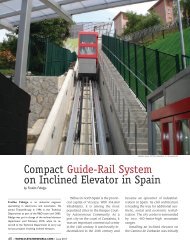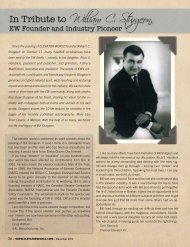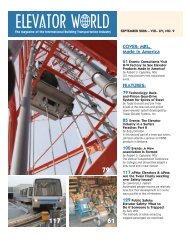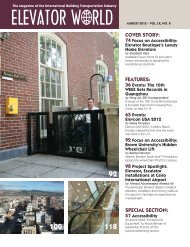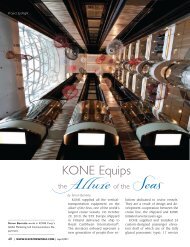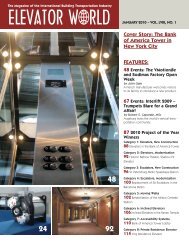iwalk â The Newest Moving Walk by ThyssenKrupp ... - Elevator World
iwalk â The Newest Moving Walk by ThyssenKrupp ... - Elevator World
iwalk â The Newest Moving Walk by ThyssenKrupp ... - Elevator World
Create successful ePaper yourself
Turn your PDF publications into a flip-book with our unique Google optimized e-Paper software.
Technology<br />
<strong>iwalk</strong> – <strong>The</strong> <strong>Newest</strong> <strong>Moving</strong> <strong>Walk</strong><br />
<strong>by</strong> <strong>ThyssenKrupp</strong> <strong>Elevator</strong><br />
<strong>by</strong> Carmen Maldacena, EW Correspondent<br />
<strong>The</strong> São Paulo Metro is the stage where the <strong>iwalk</strong>,<br />
an innovative moving walk, was recently launched <strong>by</strong><br />
<strong>ThyssenKrupp</strong> Elevadores of Brazil. This new means of<br />
transportation was conceived and built in Spain as a solution<br />
to facilitate the assembly, transportation and installation<br />
of conventional moving walks. It is a green model<br />
that follows a sustainable concept and adds passenger<br />
comfort. Six <strong>iwalk</strong> units were installed to link two São<br />
Paulo metro stations, ultimately improving the travel of<br />
thousands of subway users in the congested metropolis.<br />
Within the framework of the city’s metro expansion,<br />
<strong>ThyssenKrupp</strong> <strong>Elevator</strong> added the <strong>iwalk</strong> to its escalators<br />
and elevators to contribute to the swift movement of passengers<br />
(ELEVATOR WORLD, August 2008). Your reporter<br />
got a firsthand experience riding the <strong>iwalk</strong>s during a recent<br />
visit to the new stations, which also feature glass gates on<br />
the platform edges: a shiny transparent tunnel that protects<br />
riders during the arrival of driverless trains.<br />
Technological/Green Solution<br />
<strong>The</strong> <strong>iwalk</strong> is a global novelty that offers solutions for<br />
heavy-duty transportation systems. It features techno -<br />
logical developments and bears a green “i” in its name to<br />
indicate its sustainable principles.<br />
<strong>The</strong> new equipment was installed in the metro to link<br />
two stations – Consolação in Green Line 2 and Paulista in<br />
Yellow Line 4.<br />
<strong>The</strong>re are six heavy-duty moving walks located at the<br />
end of the platform at the Consolação station. <strong>The</strong>y run<br />
along a 120-m tunnel to reach the top of the escalators<br />
that will take the passengers in both directions to the<br />
recently opened Paulista station. <strong>The</strong> original moving walk<br />
is equipped with new improvements. <strong>The</strong> combplate<br />
height has been significantly reduced to 7 mm (compared<br />
Continued<br />
Full view of the six <strong>iwalk</strong>s<br />
Passengers<br />
commuting in the<br />
São Paulo Metro<br />
<strong>iwalk</strong><br />
May 2011 | ELEVATOR WORLD | 55
<strong>iwalk</strong> – <strong>The</strong> <strong>Newest</strong> <strong>Moving</strong> <strong>Walk</strong> <strong>by</strong> <strong>ThyssenKrupp</strong> <strong>Elevator</strong> Continued<br />
to the 40 mm of standard models). This provides an easier<br />
walk on its surface and a safer passage between the fixed<br />
and mobile sections of the equipment for passengers<br />
pulling wheeled items over the combs. <strong>The</strong> <strong>iwalk</strong> claims<br />
to be the only moving walk that offers this characteristic<br />
on the international market.<br />
<strong>The</strong> <strong>iwalk</strong> was designed to be environmentally friendly.<br />
Its driving system minimizes lubrication <strong>by</strong> oil drops (the<br />
pallets do not need lubrication) and reduces the number<br />
of components, as well as the power consumption of the<br />
machine. <strong>The</strong> moving walk remains in stand<strong>by</strong> position<br />
when not in use. With <strong>ThyssenKrupp</strong> Energy Control intelligent<br />
technology, the speed increases gradually only when<br />
the rider treads on the <strong>iwalk</strong>. This system is also used in<br />
conventional moving walks supplied <strong>by</strong> the company.<br />
Easy Installation/Flexible Transportation<br />
Another convenient characteristic of the <strong>iwalk</strong> is the<br />
system’s division into modules, which makes manufacture<br />
and installation easier and more flexible. <strong>The</strong> reduced<br />
number of components includes transportation advantages<br />
and facilitates assembly at the jobsite. As a compact<br />
product, it can be transported in containers sparing some<br />
of the room usually needed to store regular moving-walk<br />
components at building sites. With this new concept, it is<br />
possible to install moving walks where they were once<br />
unfeasible. Moreover, the fewer components used, the<br />
faster the assembly. <strong>The</strong> practice of complete assembly in<br />
the factory has been replaced <strong>by</strong> a serial production of the<br />
central sections that are assembled to the entrance and<br />
exit platforms at the jobsite.<br />
<strong>The</strong> <strong>iwalk</strong> does not require a special structure, since it<br />
can be installed on existing floors. This is possible because<br />
it is self-contained in its own guide rails where the palettes<br />
run, avoiding costly guide-rail adjustments that are necessary<br />
in traditional installations. This moving walk requires<br />
only a 380-mm-deep pit, whereas the conventional models<br />
need an approximately 1.15-m-deep pit.<br />
Attractive Design/Added Comfort<br />
<strong>The</strong> design of the <strong>iwalk</strong> had to be in accordance with<br />
the simple, yet elegant architectural trends of today. With<br />
Central safety walkway<br />
A side view of <strong>ThyssenKrupp</strong>’s new moving walks<br />
<strong>iwalk</strong> balustrades in detail<br />
Riding at full speed on the <strong>iwalk</strong>s<br />
56 | WWW.ELEVATORWORLD.COM | May 2011
this aim, the balustrades and handrails follow curving<br />
lines with no edges, complemented with the use of glass<br />
panels rendering a slim, transparent and light structure.<br />
<strong>The</strong> installation of a moving walk to connect two stations<br />
intends to provide the subway users with a faster and<br />
more comfortable passage through the tunnel. At a<br />
speed of 0.65 mps, it takes 3 minutes to reach the opposite<br />
end.<br />
<strong>The</strong> combplate design facilitates improved accessibility<br />
for those using wheelchairs or similar wheeled items.<br />
Traveling in the São Paulo Metro Network<br />
In 2008, your reporter discussed the overall figures<br />
regarding the extension and modernization program <strong>by</strong> the<br />
Companhia do Metropolitano de São Paulo that involved<br />
an estimated investment of BRL21 billion (US$12.3 billion).<br />
During this visit, <strong>ThyssenKrupp</strong> Elevadores and the metro<br />
company’s representatives accompanied your reporter on<br />
a ride from the new Faria-Lima to Paulista metro stations,<br />
both located in Yellow Line 4. This is among the first lines<br />
in Latin America to feature glass partitions to separate<br />
the platforms from the rails in all the stations. <strong>The</strong> gates<br />
open with those of the trains, avoiding accidents and<br />
other operating complications. <strong>The</strong> illumination system<br />
is efficient with electronic reactors, high-performance<br />
reflectors and fluorescent lamps.<br />
<strong>The</strong> Faria-Lima station is equipped with four stainlesssteel<br />
<strong>ThyssenKrupp</strong> machine-room-less (MRL) elevators<br />
for accessibility and 10 escalators. Your reporter observed<br />
how the metro employees were trained on the use of the<br />
elevators so that they could instruct passengers with special<br />
needs. <strong>The</strong> recently opened station uses new driverless<br />
trains manufactured <strong>by</strong> Hyundai in South Korea.<br />
<strong>The</strong>ir automatic operation is safer, and the speed is always<br />
kept within the permitted ranges according to need. <strong>The</strong><br />
trains are not divided into separate wagons; they are a long,<br />
articulated corridor so that passengers can circulate freely<br />
between the sections. Passengers have a full view of the<br />
whole train and can see it traveling into the tunnels.<br />
Once the group and your reporter arrived at Paulista<br />
station, we went up the escalators, then directly onto the<br />
<strong>iwalk</strong>s that took us along the passageway to flow into<br />
Consolação station. In Paulista station, in addition to<br />
the six connecting <strong>iwalk</strong>s, there are six panoramic elevators<br />
and 18 escalators (also supplied and installed <strong>by</strong><br />
<strong>ThyssenKrupp</strong> Elevadores).<br />
ViaQuatro is responsible for the operation and maintenance<br />
of Line 4. This private/public partnership will invest<br />
more than US$2 billion in the line. When it is finished, it<br />
will cover 12.8 km with 11 stations.<br />
Acknowledgments: Journalist Isabel Munhoz Silvares<br />
and photographer Dario de Freitas.<br />
<br />
Faria-Lima metro station with safety glass partitions on the platform edge<br />
<strong>ThyssenKrupp</strong>’s MRL elevator<br />
Model Synergy operated<br />
<strong>by</strong> a gearless machine<br />
located inside the shaft.<br />
<strong>The</strong> Paulista Station machine<br />
has a capacity of 600 kg<br />
and speed of 1 mps.<br />
Boarding platform at Paulista station: detail of the platform and train gates coordinated<br />
for boarding<br />
May 2011 | ELEVATOR WORLD | 57



